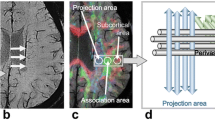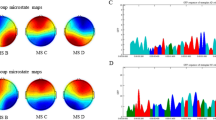Abstract
Introduction
White matter hyperintensities (WMHs) are a risk factor for Alzheimer’s disease (AD). This study investigated the relationship between WMHs and white matter changes in AD using diffusion tensor imaging (DTI) and the sensitivity of each DTI index in distinguishing AD with WMHs.
Methods
Forty-four subjects with WMHs were included. Subjects were classified into three groups based on the Scheltens rating scale: 15 AD patients with mild WMHs, 12 AD patients with severe WMHs, and 17 controls with mild WMHs. Fractional anisotropy (FA), mean diffusivity (MD), radial diffusivity (DR), and axial diffusivity (DA) were analyzed using the region of interest and tract-based spatial statistics methods. Sensitivity and specificity of DTI indices in distinguishing AD groups from the controls were evaluated.
Results
AD patients with mild WMHs exhibited differences from control subjects in most DTI indices in the medial temporal and frontal areas; however, differences in DTI indices from AD patients with mild WMHs and AD patients with severe WMHs were found in the parietal and occipital areas. FA and DR were more sensitive measurements than MD and DA in differentiating AD patients from controls, while MD was a more sensitive measurement in distinguishing AD patients with severe WMHs from those with mild WMHs.
Conclusions
WMHs may contribute to the white matter changes in AD brains, specifically in temporal and frontal areas. Changes in parietal and occipital lobes may be related to the severity of WMHs. DR may serve as an imaging marker of myelin deficits associated with AD.





Similar content being viewed by others
Abbreviations
- MRI:
-
Magnetic resonance imaging
- DTI:
-
Diffusion tensor imaging
- WMHs:
-
White matter hyperintensities
- AD:
-
Alzheimer’s disease
- TBSS:
-
Tract-based spatial statistics
- FA:
-
Fractional anisotropy
- MD:
-
Mean diffusivity
- DR :
-
Radial diffusivity
- DA :
-
Axial diffusivity
- ROC:
-
Receiver operator characteristics
- AUC:
-
Area under curve
- AIC:
-
Anterior internal capsule
- PIC:
-
Posterior internal capsule
References
Schmidt R, Schmidt H, Kapeller P, Enzinger C, Ropele S et al (2002) The natural course of MRI white matter hyperintensities. J Neurol Sci 203–204:253–257
Gunning-Dixon FM, Brickman AM, Cheng JC, Alexopoulos GS (2009) Aging of cerebral white matter: a review of MRI findings. Int J Geriatr Psychiatry 24:109–117
Madden DJ, Bennett IJ, Song AW (2009) Cerebral white matter integrity and cognitive aging: contributions from diffusion tensor imaging. Neuropsychol Rev 19:415–435
Appel J, Potter E, Bhatia N, Shen Q, Zhao W et al (2009) Association of white matter hyperintensity measurements on brain MR imaging with cognitive status, medial temporal atrophy, and cardiovascular risk factors. AJNR Am J Neuroradiol 30:1870–1876
Lee DY, Fletcher E, Martinez O, Ortega M, Zozulya N et al (2009) Regional pattern of white matter microstructural changes in normal aging, MCI, and AD. Neurology 73:1722–1728
Riekse RG, Leverenz JB, McCormick W, Bowen JD, Teri L et al (2004) Effect of vascular lesions on cognition in Alzheimer’s disease: a community-based study. J Am Geriatr Soc 52:1442–1448
Hirono N, Kitagaki H, Kazui H, Hashimoto M, Mori E (2000) Impact of white matter changes on clinical manifestation of Alzheimer’s disease: a quantitative study. Stroke 31:2182–2188
Cheong JL, Thompson DK, Wang HX, Hunt RW, Anderson PJ et al (2009) Abnormal white matter signal on MR imaging is related to abnormal tissue microstructure. AJNR Am J Neuroradiol 30:623–628
Huang J, Friedland RP, Auchus AP (2007) Diffusion tensor imaging of normal-appearing white matter in mild cognitive impairment and early Alzheimer disease: preliminary evidence of axonal degeneration in the temporal lobe. AJNR Am J Neuroradiol 28:1943–1948
Zhang Y, Schuff N, Du AT, Rosen HJ, Kramer JH et al (2009) White matter damage in frontotemporal dementia and Alzheimer’s disease measured by diffusion MRI. Brain 132:2579–2592
Rose SE, Janke AL, Chalk JB (2008) Gray and white matter changes in Alzheimer’s disease: a diffusion tensor imaging study. J Magn Reson Imaging 27:20–26
Xie S, Xiao JX, Gong GL, Zang YF, Wang YH et al (2006) Voxel-based detection of white matter abnormalities in mild Alzheimer disease. Neurology 66:1845–1849
Klingberg T, Vaidya CJ, Gabrieli JD, Moseley ME, Hedehus M (1999) Myelination and organization of the frontal white matter in children: a diffusion tensor MRI study. Neuroreport 10:2817–2821
Song SK, Sun SW, Ramsbottom MJ, Chang C, Russell J et al (2002) Dysmyelination revealed through MRI as increased radial (but unchanged axial) diffusion of water. Neuroimage 17:1429–1436
Budde MD, Xie M, Cross AH, Song SK (2009) Axial diffusivity is the primary correlate of axonal injury in the experimental autoimmune encephalomyelitis spinal cord: a quantitative pixelwise analysis. J Neurosci 29:2805–2813
Wheeler-Kingshott CA, Cercignani M (2009) About “axial” and “radial” diffusivities. Magn Reson Med 61:1255–1260
Gouw AA, Seewann A, Vrenken H, van der Flier WM, Rozemuller JM et al (2008) Heterogeneity of white matter hyperintensities in Alzheimer’s disease: post-mortem quantitative MRI and neuropathology. Brain 131:3286–3298
Mckhann G, Drachman D, Folstein M, Katzman R, Price D et al (1984) Clinical-diagnosis of Alzheimers-disease—report of the Nincds-Adrda work group under the Auspices of Department-of-health-and-human-services task-force on Alzheimers-disease. Neurology 34:939–944
Scheltens P, Barkhof F, Leys D, Pruvo JP, Nauta JJ et al (1993) A semiquantative rating scale for the assessment of signal hyperintensities on magnetic resonance imaging. J Neurol Sci 114:7–12
Wahlund LO, Barkhof F, Fazekas F, Bronge L, Augustin M et al (2001) A new rating scale for age-related white matter changes applicable to MRI and CT. Stroke 32:1318–1322
Smith SM, Jenkinson M, Johansen-Berg H, Rueckert D, Nichols TE et al (2006) Tract-based spatial statistics: voxelwise analysis of multi-subject diffusion data. Neuroimage 31:1487–1505
Capizzano AA, Acion L, Bekinschtein T, Furman M, Gomila H et al (2004) White matter hyperintensities are significantly associated with cortical atrophy in Alzheimer’s disease. J Neurol Neurosurg Psychiatry 75:822–827
Lee PH, Oh SH, Bang OY, Joo IS, Huh K (2005) Pathogenesis of deep white matter medullary infarcts: a diffusion weighted magnetic resonance imaging study. J Neurol Neurosurg Psychiatry 76:1659–1663
Chen SQ, Kang Z, Hu XQ, Hu B, Zou Y (2007) Diffusion tensor imaging of the brain in patients with Alzheimer’s disease and cerebrovascular lesions. J Zhejiang Univ Sci B 8:242–247
DeCarli C, Grady CL, Clark CM, Katz DA, Brady DR et al (1996) Comparison of positron emission tomography, cognition, and brain volume in Alzheimer’s disease with and without severe abnormalities of white matter. J Neurol Neurosurg Psychiatry 60:158–167
O’Brien JT, Wiseman R, Burton EJ, Barber B, Wesnes K et al (2002) Cognitive associations of subcortical white matter lesions in older people. Ann N Y Acad Sci 977:436–444
Schmidt R, Ropele S, Enzinger C, Petrovic K, Smith S et al (2005) White matter lesion progression, brain atrophy, and cognitive decline: the Austrian stroke prevention study. Ann Neurol 58:610–616
Damoiseaux JS, Smith SM, Witter MP, Sanz-Arigita EJ, Barkhof F et al (2009) White matter tract integrity in aging and Alzheimer’s disease. Hum Brain Mapp 30:1051–1059
Zarei M, Damoiseaux JS, Morgese C, Beckmann CF, Smith SM et al (2009) Regional white matter integrity differentiates between vascular dementia and Alzheimer disease. Stroke 40:773–779
Lee JH, Olichney JM, Hansen LA, Hofstetter CR, Thal LJ (2000) Small concomitant vascular lesions do not influence rates of cognitive decline in patients with Alzheimer disease. Arch Neurol 57:1474–1479
Wang L, Goldstein FC, Veledar E, Levey AI, Lah JJ et al (2009) Alterations in cortical thickness and white matter integrity in mild cognitive impairment measured by whole-brain cortical thickness mapping and diffusion tensor imaging. AJNR Am J Neuroradiol 30:893–899
Seo SW, Im K, Lee JM, Kim YH, Kim ST et al (2007) Cortical thickness in single- versus multiple-domain amnestic mild cognitive impairment. Neuroimage 36:289–297
Acknowledgements
This study was supported in part by a grant from NIH (R21AG027335 to HM) and a pilot project grant from The Emory Alzheimer’s Disease Research Center (NIH-NIA P50 AG025688 to HM).
The authors thank Dr. Longchuan Li (Department of Biomedical Engineering, Emory University) and Dr. Xiaodong Zhong (MR R&D Collaborations, Siemens Medical Solutions) for their assistances and helpful discussions.
Conflict of interest
We declare we have no conflict of interest.
Author information
Authors and Affiliations
Corresponding author
Rights and permissions
About this article
Cite this article
Wang, L., Goldstein, F.C., Levey, A.I. et al. White matter hyperintensities and changes in white matter integrity in patients with Alzheimer’s disease. Neuroradiology 53, 373–381 (2011). https://doi.org/10.1007/s00234-010-0806-2
Received:
Accepted:
Published:
Issue Date:
DOI: https://doi.org/10.1007/s00234-010-0806-2




